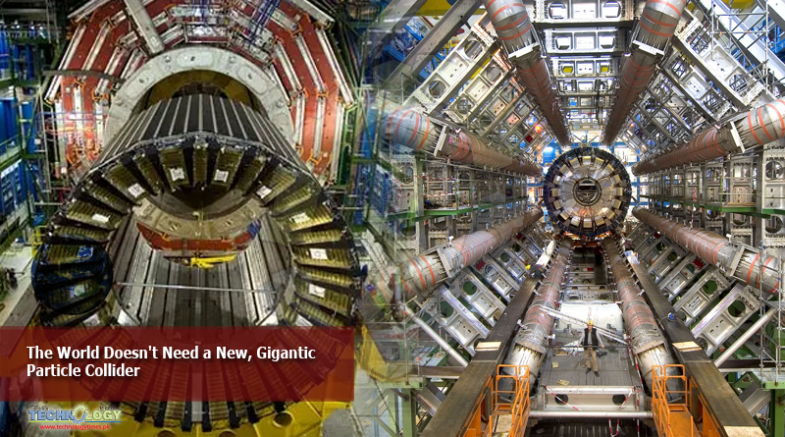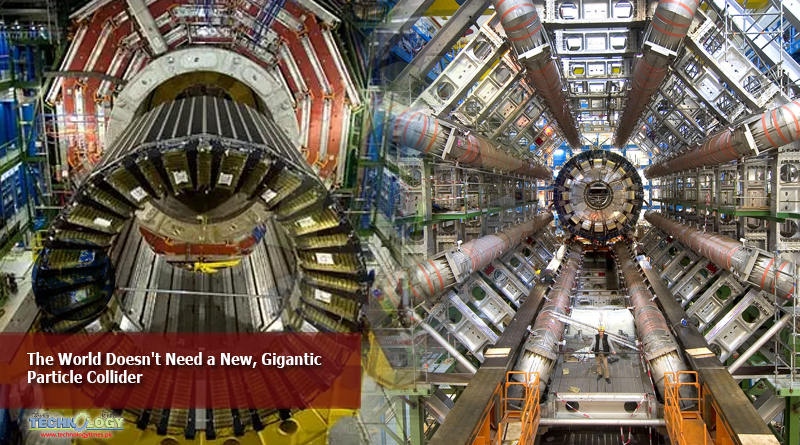It would cost many billions of dollars, the potential rewards are unclear—and the money could be better spent researching threats like climate change and emerging viruses. With that, CERN has decided it wants to go ahead with the first step of a plan for the Future Gigantic Particle Collider.

This is not the right time for a bigger particle accelerator. But CERN, the European physics center based in Geneva, Switzerland, has plans—big plans. The biggest particle physics facility of the world, currently running the biggest particle collider in the world, has announced it aims to build an even bigger machine, as revealed in a press conference and release today.
With that, CERN has decided it wants to go ahead with the first step of a plan for the Future Circular Collider (FCC), hosted in a ring-shaped tunnel 100 kilometers, or a bit over 60 miles, in circumference. This machine could ultimately reach collision energies of 100 tera-electron-volts, about six times the collision energy of the currently operating Large Hadron Collider (LHC). By reaching unprecedentedly high energies, the new collider would allow the deepest look into the structure of matter yet, and offer the possibility of finding new particles.
Whether the full vision will come into existence is still unclear. But CERN has announced it is of “high priority” for the organization to take the first step on the way to the FCC: finding a suitable site for the tunnel and building a machine to collide electrons and positrons at energies similar to that of the LHC (which however uses protons on protons). The decision whether CERN will then move forward to the high energy collisions between protons will only come after several more years of study and deliberation.
This first step has also been dubbed a “Higgs factory”, because it is especially designed to produce large amounts of Higgs bosons. The Higgs boson, discovered at CERN in 2012, was the final missing particle in the Standard Model of particle physics. With the new machine, particle physicists want to measure its properties, and the properties of some previously discovered particles, in more detail. (Japan is considering building a linear collider with a similar purpose as CERN’s Higgs factory, but the committee working on the idea made no definitive decision in their last year’s report. China is considering a circular collider similar in scope and size to CERN’s full FCC plan, but a decision is not expected until next year.)
But CERN’s plan, if fully executed, would cost tens of billions of dollars. Exact numbers are not available because budget estimates put forward by CERN usually do not include the cost of operation. Going by the running costs for the Large Hadron Collider, those costs for the new collider would probably amount to at least $1 billion per year. For a facility that may operate for 20 years or more, this is comparable to the construction costs.
These are eye-popping numbers, no doubt. Indeed, particle colliders are currently the most expensive physics experiments in existence. Their price tag is higher than that of even the next most expensive type of experiments, telescopes on satellite missions.
The major reason the cost is so high is that that, since the 1990s, there have only been incremental improvements in collider technology. As a consequence, the only way to reach higher energies today is building bigger machines. It is the sheer physical size—the long tunnels, the many magnets need to fill it, and all the people needed to get that done—that makes particle colliders so expensive.
But while the cost of these Gigantic Particle Collider. has ballooned, their relevance has declined. When physicists started building colliders in the 1940s, they did not have a complete inventory of elementary particles, and they knew it. New measurements brought up new puzzles, and they built bigger colliders until, in 2012, the picture was complete. The Standard Model still has some loose ends, but experimentally testing those would require energies at least ten billion times higher than what even the FCC could test. The scientific case for a next larger collider is therefore presently slim.
Of course, it is possible that a next larger collider would make a breakthrough discovery. Some physicists hope, for example, it could offer clues about the nature of dark matter or dark energy.
Yes, one can hope. But there is no reason why the particles that make up dark matter or dark energy should show up in the new device’s energy range. And that is assuming they are particles to begin with, for which there no evidence. Even if they are particles, moreover, highly energetic collisions may not be the best way to look for them. Weakly interacting particles with tiny masses, for example, are not something one looks for with large colliders.
And there are entirely different types of experiments that could lead to breakthroughs at far smaller costs, such as high precision measurements at low energies or increasing the masses of objects in quantum states. Going to higher energies is not the only way to make progress in the foundations of physics; it’s just the most expensive one.
In this situation, particle physicists should focus on developing new technologies that could bring colliders back in a reasonable price range and hold off digging more tunnels. The most promising technology on the horizon is a new type of “wake field” acceleration that could dramatically decrease the distance necessary to speed up Gigantic Particle Collider, and hence shrink the size of colliders. Another game-changing technology would be room-temperature superconductors that could make the strong magnets that colliders rely on more efficient and affordable.
Looking into these new technologies is also among CERN’s priorities. But as the strategy update reveals, particle physicists have not woken up to their new reality. Building larger particle colliders has run its course. It has today little scientific return on investment, and at the same time almost no societal relevance. Large scientific projects tend to generally benefit education and infrastructure, but this is not specific to Gigantic Particle Collider..And if it those side effects are what we are really interested in, then we should at least put our money into scientific research with societal relevance.
Why, for example, do we still not have an international center for climate predictions Gigantic Particle Collider., which by current estimates would cost “only” $1 billion spread over 10 years? That’s peanuts compared to what particle physics sucks up, yet vastly more important. Or why, you may have wondered recently, do we not have a center for epidemic modeling?
It’s because too much science funding is handed out on the basis of inertia. In the past century, particle physics has grown into a large, very influential and well-connected community. They will keep on building bigger particle colliders as long as they can, simply because that’s what particle physicists do, whether that makes sense or not.
It’s about time society takes a more enlightened approach to funding large science projects than continuing to give money to those they have previously given money to. We have bigger problems than measuring the next digit on the mass of the Higgs boson.
Originally Publish at: https://www.scientificamerican.com/
